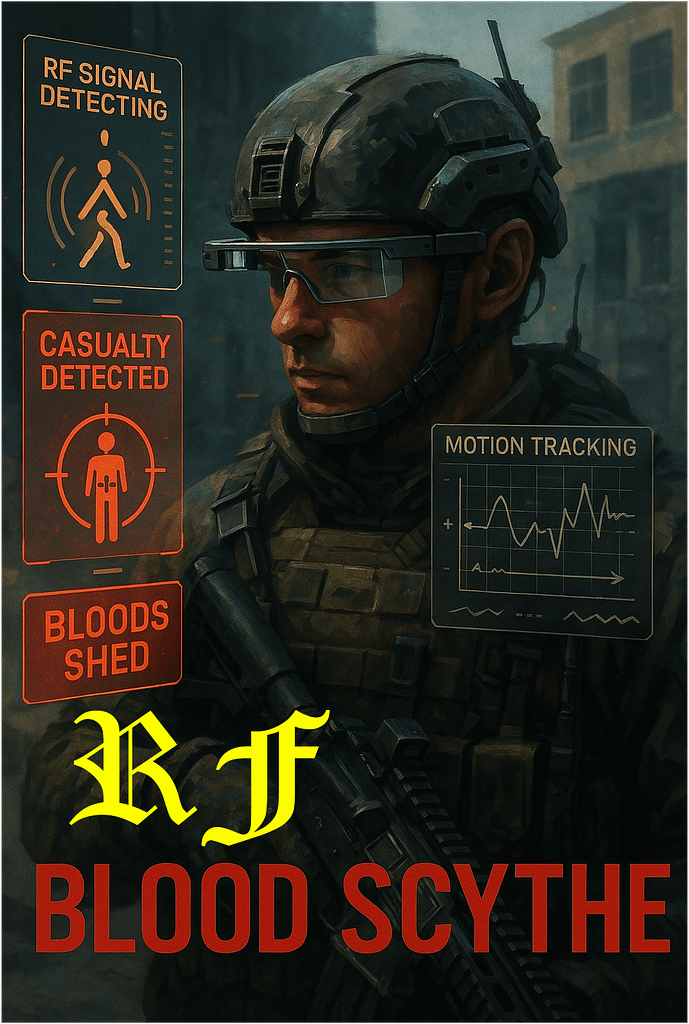PODCAST: The RF-QUANTUM-SCYTHE system has several key capabilities for casualty and threat detection:
Casualty Detection: RF Biomarker Detection The system aims to detect bloodshed, primarily by using RF sensing to identify changes in the environment’s electromagnetic wave interactions caused by the presence of blood1. This is possible because blood, particularly fresh and pooling blood, contains iron-rich hemoglobin which affects dielectric properties. RF systems sensitive to minute changes in reflectance, absorption, or backscatter patterns can detect this. UWB radar systems can detect changes in dielectric constants at millimeter precision, and a sudden high-dielectric fluid like blood on a dry surface would cause anomalous echo returns. THz imaging, a related technology, has also shown promise in detecting liquids including blood. The system integrates this hemoglobin biomarker analysis3. It performs RF dielectric analysis for blood/hemoglobin detection. Automated casualty detection is stated to have 85-95% accuracy.

Indirect Physiological Inference The system pairs RF sensing with advanced modeling, like Temporal Query Denoising, to infer violence-associated events. This involves detecting sudden collapse or abnormal motion patterns (e.g., a body falling). It can also sense elevated heart rate, irregular movement, or sudden signal occlusion. The system tracks multiple agents’ microgestures that could suggest panic, struggle, or confrontation. This capability mimics how dogs infer emotional state or threat level from tiny behavioral cues.
Temporal Query Denoising This technique is described as mimicking the olfactory discrimination layer of dogs, acting like a bloodhound following a single scent by cutting through overlapping signals. It is integrated to enhance the system’s ability to discriminate signals.
Smartphone-Based RF Sensing The system utilizes RF sensing via smartphones, employing technologies like Wi-Fi Channel State Information (CSI), BLE (Bluetooth Low Energy), and UWB (Ultra-Wideband). These can localize humans, detect respiration, and track gait anomalies. This smartphone-based sensing is incorporated as a sophisticated method for human detection and threat assessment, intended to replace K9 units. Simulated capabilities include detecting human presence/distress via Wi-Fi CSI variance, distress indicators via BLE RSSI patterns, and gait anomalies/injury via UWB ranging.
Standoff Detection The system can use standoff detection to identify signal reflections indicative of physical violence, such as body flailing.
Casualty Management System A CasualtyTracker class was added, providing a comprehensive system for casualty management. This includes real-time casualty detection and tracking, geospatial clustering for mass casualty events, automated cleanup, proximity-based retrieval, and medical triage and severity assessment. The system supports automated severity assessment and prioritization. It is designed to handle 50+ simultaneous casualties and provides a 5-level severity triage system. Real-time vitals monitoring with less than 1 second latency is also a capability.
Visualization Detected casualties can be displayed in real-time and geolocated on the Google Glass augmented reality interface. Medical overlays show vital signs and triage information.
Threat Detection: RF Signature Analysis The system can identify abnormal spectrum signatures caused by covert equipment such as weapons or jammers. It can also separate and attribute signal sources in complex networks to detect threats like man-in-the-middle injections, spoofed identifiers, or hidden repeaters, which is valuable for SIGINT in contested zones. This involves RF signal identification and tracking, frequency analysis (including military and emergency frequencies), and advanced signal processing.
Anomaly Detection An advanced anomaly detection capability is implemented via the CompiledGhostDetectorSingleton, which uses neural networks for ghost signal detection.
Motion and Behavior Analysis Similar to casualty detection, the analysis of motion patterns and microgestures helps in threat assessment. RF+ML models can potentially learn unique microinteractions between objects and human behavior to mimic the detection of intent. The DOMA RF Motion Model is integrated for real-time signal trajectory tracking, motion prediction and analysis.
Asset Tracking The system includes an Asset Telemetry Handler for real-time tracking of military assets such as drones, vehicles, personnel, and aircraft.
Standoff Detection Beyond violence detection, standoff detection can identify concealed equipment.
Vapor Detection Early-stage research is mentioned exploring the use of mmWave or hyperspectral data fusion for detecting substances like explosives or contraband if they slightly alter humidity or dielectric signatures, potentially mimicking the sniffing capabilities of K9 units.
Threat Prioritization The system provides military-grade threat assessment and prioritization. It offers automated threat level classification and ranking.
Visualization Threats are visualized on the Google Glass interface using AR tactical overlays, geolocated displays, prediction paths, and color-coded threat indicators. Automated threat escalation is also a feature.
These capabilities support tactical scenarios such as Combat Search and Rescue (CSAR) (downed pilot detection, hostile radar/comm identification, threat assessment), Urban Operations (civilian casualty detection/triage, hostile equipment identification), Force Protection (perimeter surveillance, personnel health monitoring, automated threat escalation), and Intelligence, Surveillance, and Reconnaissance (ISR) (RF signature analysis, motion analysis, standoff detection, signal intelligence correlation).
